AREA SETUP
(Open thematic poster-Habitats) Print, laminate, and display all kinds of posters.
Educa-decorate-Habitats
(Open educa-decorate-Habitats) Print, cut out, and laminate. Use the items to decorate the walls of your daycare and set the mood for the theme. Hang various items representing different habitats from the ceiling in your daycare: a bird's nest, a cactus, a tree branch, a seashell, etc. Organize your daycare in a way that each corner represents a different habitat. For example, one corner can become a desert, another corner can represent a forest, another one can be decorated to look like the Arctic, etc.
SPECIAL TOOL
This special tool was created in response to a special request received. (Open poster-Important numbers with photos) Print and laminate.
CIRCLE TIME
Invite children to bring a picture of their home to daycare. During circle time, explain to your group how a habitat is in fact where an insect or an animal lives. Help them understand how an animal's habitat is a lot like their home.
My exploration boxes-Habitats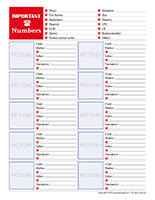
(Open labels-Exploration boxes-Habitats) Every morning, open one or two exploration boxes to spark a discussion about the corresponding habitat(s).
- Invite children to name the animals that live in the habitat.
- Give children the opportunity to manipulate the objects so they can familiarize themselves with them.
- Encourage children to share stories about experiences they had in the different environments, if applicable.
- etc.
The ocean: sand, small seashells, feathers, rocks, empty shells, sand dollars, pictures of marine animals, a bottle filled with salt water, etc.
The forest: branches of coniferous trees, pinecones, rocks, small logs, leaves from a variety of trees, pictures of forest animals, acorns, etc.
The desert: sand, cacti, pictures of desert animals, pictures of desert scenes, etc.
The marsh: plastic algae, pictures of reptiles, frogs, insects, lily pads, etc.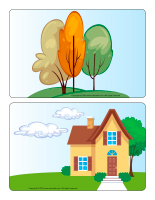
The Arctic: pictures of polar animals, an ice cube tray, granulated sugar or salt (to represent snow), a thermometer, etc.
A house: miniature furniture items from dollhouses, figurines representing various family members, pictures of different types of homes, etc.
Use educatall.com's picture games to fill your exploration boxes. You will find pictures of insects, fish, animals, etc. as well as many printable documents that can be used to help children discover different habitats.
PICTURE GAME
(Open picture game-Habitats) Use the pictures to decorate your daycare or to spark a conversation with your group. Print, laminate, and store the pictures in a Ziploc bag or in your thematic bin.
WRITING ACTIVITIES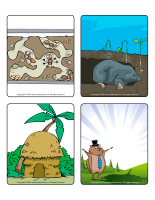
(Open writing activities-H like habitat) Print for each child or laminate for use with a dry-erase marker.
Stationery-Habitats
(Open stationery-Habitats) Print. Use the stationery to communicate with parents, in your writing corner, or to identify your thematic bins.
ACTIVITY SHEETS
(Open activity sheets-Habitats) Print and follow instructions.
Educa-nuudles-Habitats
(Open educa-nuudles-Habitats) Print for each child. Have children color the sheet. Once they are done, they may use Magic Nuudles to turn the coloring pages into three- dimensional works of art. Variation: If you do not have Magic Nuudles, ask children to fill the spaces designed for Magic Nuudles with bingo markers or stickers. To order Magic Nuudle.
LANGUAGE ACTIVITIES
Word flashcards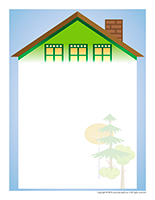
Use the cards to spark a conversation with your group or in your reading and writing area. They may also be used to identify your thematic bins. (Open word flashcards-Habitats) Print. tree, soil, hut, igloo, burrow, house, anthill, beehive, pond, doghouse, cage, ocean
Sequential story-Habitats
(Open sequential story-Habitats) Print and laminate the various cards. Children must place them in the correct order.
Picture clue story-The desert
(Open picture clue story-The desert) Print. Sit in a circle with your group. Begin reading the story. Every time you reach a picture clue, pause and point to it. Children must guess the missing word to complete the sentence.
ROUTINES AND TRANSITIONS
Game-This is my spot-Habitats
(Open transition games-Habitats) Print two copies. Laminate and cut out the cards. Glue one copy of each card on the table using adhesive paper. Drop the other copies in a bag. Children take turns picking a card to determine their spot at the table for the day. You may also use the cards to determine naptime spots or for your task train.
Follow the animal tracks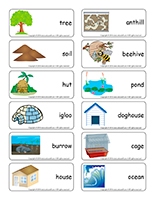
(Open jungle animal tracks) Print as many tracks as you wish. Use adhesive paper to arrange the tracks on the floor of your daycare to create paths leading to different areas. You can invite children to represent the sound each animal makes as they walk along the various paths.
Animal moves
As you move about in your daycare, encourage children to act out actions associated with different types of animals.
ACTIVITIES FOR BABIES
An ocean in a bag
You will need a strong plastic bag such as a Ziploc bag. Add blue hair gel, sand, a few small rocks (for aquariums), and tiny seashells to the bag. Seal the bag and let children manipulate it. If you wish, create several different bags. You can also set the bags in the freezer or refrigerator to give children the opportunity to feel a cold sensation or add colourful gummy fish.
The farm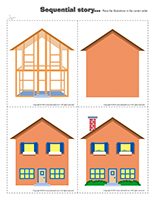
Fill a clear plastic bag with wood shavings and add animal figurines (hen, horse, sheep, pig, chicks, rabbit, farmer, etc.). Children will love to play with this miniature "farm".
Frog pond
Set a kiddie pool on the floor, in the centre of your daycare. Deposit several colourful plastic frogs inside. Let children manipulate them and play with them as they wish.
PHYSICAL ACTIVITIES AND MOTOR SKILLS
Habitat obstacle course
Set up an obstacle course representing various habitats in your daycare (or in your yard if the weather is nice). You can use pictures of animals available in the educatall club to identify the habitats. Use the items you have on hand to add challenges for your group.
A balance beam can become a beaver dam or a fallen tree that squirrels, deer or other forest animals must cross.
Stilts can be used to cross a marsh or pond to avoid the small animals that live in it. You can, for example, glue pictures of frogs on the floor and encourage children to walk around them.
If you don't have stilts, you may choose to glue pictures of lily pads on the floor and have children hop from one lily pad to the next.
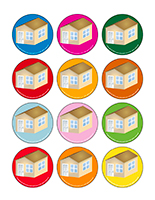 If you have a tunnel, it can represent a hollow tree trunk that children must crawl through to avoid a ravine.
If you have a tunnel, it can represent a hollow tree trunk that children must crawl through to avoid a ravine.
Hula hoops can become river rocks that children must walk on to cross a river without getting wet. If you prefer, you can simply cut rock shapes out of grey cardboard and set them on the floor.
As you can see, it is easy to incorporate the items you already have in your daycare. Other simple examples are colourful adhesive tape that can be used to draw various obstacles on the floor, a parachute that can be set up in a strategic location, chairs that children can climb over or crawl under, etc.
If you choose to set your obstacle course up outside, your sandbox can represent a desert. Simply add plastic insects or small animals that children can collect as they cross it.
Your playground equipment can become a jungle. Just add a few decorative items for fun!
On a hot day, kiddie pools can represent different aquatic habitats (lake, river, ocean, etc.).
Twister-Habitats
(Open twister-Habitats) Print. Glue the large pictures on the floor using adhesive tape. Arrange them to create a 4 ft x 4 ft playing area. The leader of the game picks one habitat card and one body part card, as in the traditional Twister game. He/she can say, "Place one foot on the forest, place one hand on the house..." Variation for younger children: Simply use the illustrations to decorate your daycare or for a simple recognition game. You can, for example, ask children to identify the forest. Very young children will simply enjoy crawling from one picture to the next. You can use adhesive paper to display them on the floor or at the bottom of your daycare walls.
It's raining in the forest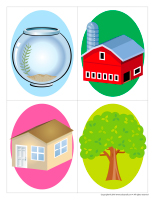
(Open models-Leaves) Print and cut out enough leaves so that you have at least ten per child. Place all the leaves in the centre of your parachute (or a blanket). Ask children to firmly hold on to the edge of the parachute. When you give them the signal, they must raise the parachute over their head to send the leaves flying through the air. As the leaves fall back to the ground, children must collect as many leaves as they can. Count how many leaves each child was able to collect and start all over again.
OUTDOOR ACTIVITIES
Snakes
(Open game-Snakes) Print and laminate. Before children arrive in the morning, hide snakes in your sandbox. When you go outside with your group, invite them to hunt for snakes. Every time a child finds one, he/she must cry, "A snake!" Encourage your group to gather around to look at the snake and name its color. The game continues until all the snakes have been found.
Tic-tac-toe-The desert
(Open tic-tac-toe-The desert) Print and laminate. Use sidewalk chalk to draw a tic-tac-toe grid in your yard. Give one child the X's and another child the O's. Children take turns depositing a symbol on the grid. The first child who successfully deposits three identical symbols in a row wins.
Pond hop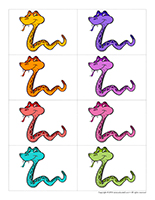
Set a bluish-green blanket or piece of cardboard on the floor to represent a frog pond. Ask children to hop over it over and over again.
MUSICAL AND RHYTHMIC ACTIVITIES
Musical animal
Play music and invite children to dance around the daycare. When you stop the music, show children a picture of an animal. They must act out actions associated with this animal while making the corresponding animal sound. When the music starts again, children resume dancing. When the music stops once more, there is a new animal to imitate.
COGNITIVE ACTIVITIES
Educ-differences-Habitats
(Open educ-differences-Habitats) Print and laminate for durable, eco-friendly use. Children must find the number of differences indicated and circle them using a dry-erase marker.
Educ-math-Habitats
(Open educ-math-Habitats) Print and laminate for durable, eco-friendly use. Children must count the objects in each rectangle and circle the corresponding number.
Educ-same and different-Habitats
(Open educ-same and different-Habitats) Print and laminate for durable, eco-friendly use. Children must circle the item that is different in each row.
Bingo-Habitats
(Open bingo-Habitats) Print, laminate, and store everything in a small box or Ziploc bag. Play bingo with your group.
Desert scene
(Open scene-The desert) Print, laminate, and cut out the pieces. Children can use them to decorate the scene over and over again.
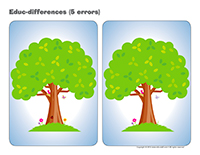
Where do animals live?
(Open game-Animal habitats) Provide several different animal figurines and ask children to associate them to the correct habitat by sorting them into categories: polar animals, zoo/jungle animals, farm animals, and pets.
Who lives where?
(Open game-Where do animals live?) Cut out the various animal cards. Ask children to sort them according to their habitat. Use this activity to explain to your group how animals don't all live in the same type of environment.
Hunt and seek-Pets
(Open hunt and seek-Pets) Print and laminate. Children pick a card and search for the item in the scene.
Hunt and seek-The desert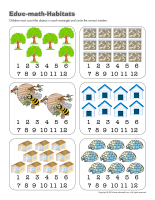
(Open hunt and seek-The desert) Print and laminate. Children pick a card and search for the item in the scene.
Hunt and seek-Frogs
(Open hunt and seek-Frogs) Print and laminate. Children pick a card and search for the item in the scene.
Hunt and seek-Insects
(Open hunt and seek-Insects) Print and laminate. Children pick a card and search for the item in the scene.
Hunt and seek-My home
(Open hunt and seek-My home) Print and laminate. Children pick a card and search for the item in the scene.
Hunt and seek-The zoo
(Open hunt and seek-The zoo) Print and laminate. Children pick a card and search for the item in the scene.
ACTIVITIES INVOLVING PARENTS
Like squirrels in the forest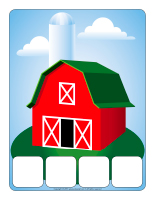
Invite parents to join you for a walk in a nearby forest. Give each child an empty tissue box he/she can use to collect items found in nature, much like squirrels do. They can fill their box with tiny branches, acorns, pinecones, leaves, etc. Admire the contents of children's boxes upon your return and use the items for various crafts and activities throughout the theme.
RELAXATION ACTIVITIES
Resting in a tent
Set up a tent in your daycare or in your yard. Deposit sleeping bags, cushions, and stuffed animals inside. Offer toys children can safely play with inside your tent.
ACTIVITIES FOR BUILDING SELF-ESTEEM
My imaginary animal and its habitat
Encourage children to create an imaginary animal. They can draw their animal or sculpt it using various recycled arts & crafts materials. When they are done, have them select a habitat for their animal. They may also find a name for their animal. Children take turns presenting their imaginary animal to the group. When they are done, they can set their animal in the corner that represents the habitat they have chosen for it.
ACTIVITIES FOR BUILDING SOCIAL SKILLS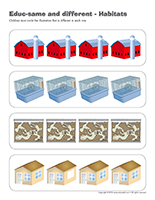
When I go...
Children sit in a circle. Each child must say, "When I go to the farm, I see..." Of course, they must complete the sentence by naming a farm animal, but only after successfully listing all the animals that were previously named by others. You may ask older to children to make the corresponding animal sounds too. Variation: This game can be adapted to explore different habitats (forest, Arctic, desert, jungle, etc.).
Our home
Use blankets and boxes to build a house with your group. Throughout the week, provide plastic containers, empty cardboard boxes, etc. Your local grocer will be happy to give you boxes. Encourage children to use their imagination to explore the items in a variety of different ways to represent a house. They will love to create several different rooms and play in their house for hours.
Our towel cabin
Use towels, tables, chairs, etc. to build a cabin with your group.
EARLY SCIENCE/EXPLORATION/MANIPULATION
Creative recipe-Sand dough
(Open creative recipe-Sand dough)
Sand dough
Ingredients:
- 1 cup of sand
- 1 cup of flour
- 1 cup of salt
- 3 tablespoons of oil
- 3 teaspoons of cream of tartar
- ½ cup of water
Steps:
- In a pot, mix all dry ingredients.
- Add wet ingredients.
- Cook the mixture over medium-low heat until it has a uniformly granular texture (much like unmelted sugar).
- The use of an old pot is recommended since the sand may scratch the surface of the pot somewhat.
- Use the dough as you would use regular modeling dough to give children the opportunity to explore new textures.
My habitat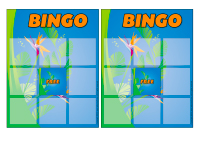
Provide a series of bins to represent various animal and insect habitats. For example, fill a bin with water for marine animals, fill another bin with hay for farm animals, fill yet another bin with tiny branches and leaves for forest animals, and another one with sand for desert animals, etc. Deposit several plastic animal figurines (or laminated animal pictures) in the centre of the table and ask children to associate them to the correct habitat.
Camel-like water carriers
Explain to your group how camels store water in their humps so they are able to walk for a very long time in the desert, without needing to drink. Fill a large container with water and use sponges to provide children with the opportunity to observe how the water is observed and stored inside the sponges. Help them realize how heavy the sponges are once they are filled with water versus how light they are when the water is squeezed out of them. Help them understand that a camel is therefore heavier when it is full of water.
Worm bin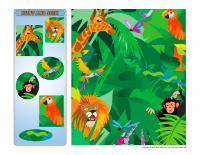
Fill a container with dirt and real worms. Add tiny magnifying glasses and other tools (small flashlights, latex gloves, etc.) children can use to explore and observe typical worm behavior.
Our nest
Set a plastic tablecloth on a table. Using mud, form a nest-like shape. Ask children to collect small branches, leaves, etc. to add to your nest. Let your nest dry. Children will be proud to show their parents their masterpiece.
CULINARY ACTIVITIES
Mud and worms
Prepare chocolate pudding. Divide it among individual bowls and crumble a few chocolate wafers on top of each portion. Add gummy worms and enjoy!
Blue sky, green grass
Cover the bottom of a baking sheet with square crackers (Soda crackers). Add cream cheese to two bowls. Add blue food coloring to the first bowl and green food coloring to the second bowl. Spread the blue cream cheese over the crackers at the top of your baking sheet to represent the sky. Spread the green cream cheese over the crackers at the bottom of your baking sheet to represent grass. Press animal-shaped crackers in the blue or green cream cheese, depending on their habitat. You can also use string cheese to represent trees. Your baking sheet will end up looking like a park or forest.
Fish live in the water-Creative recipe-My yummy aquarium
(Open creative recipe-My yummy aquarium)
My yummy aquarium
Ingredients:
- 2 boxes of blue Jell-O, prepared (approx. 4 cups)
- 4 small 1 ½ cup capacity bowls
- Gummy fish or other marine animals
Steps:
- Fill each bowl with liquid Jell-O.
- Add 3-4 fish to each bowl.
- Place the bowls in the refrigerator until the Jell-O sets.
- Add a dollop of whipped cream on top of each portion prior to serving.
- Delicious...and fun!
Igloo
With your group, melt marshmallows in a microwave-safe bowl for approximately 30 seconds. Let children take turns stirring the preparation. Continue to melt the marshmallows for 10 seconds more. Set the melted marshmallows in the centre of the table and let children use the preparation to create an igloo.
Lily pad taste test
Spread blue cream cheese (cream cheese to which you have added blue food coloring) on an English muffin to represent a pond. Cut 2-3 slices of cucumber (or zucchini) and use them to represent lily pads. Add a few gummy frogs and enjoy!
ARTS & CRAFTS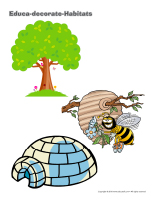
Collective project-Habitats
Hang several large pieces of white paper on a wall. Each piece of paper will represent a different habitat (forest, desert, Arctic, etc.). Provide animal-themed coloring pages. Have children color them and cut out the animals. Have them decorate the habitats using a variety of arts & crafts materials. Use this activity to discuss the characteristics of each habitat. Finally, they can associate each animal to the correct one.
The farm
Give each child an empty milk carton. They can use their milk carton to represent a barn. Let them paint it using red and black paint. Use construction paper to cut out rectangles or squares that will become barn windows and doors. Empty "Pringles" containers will make great silos. Provide farm animal-shaped cookie cutters and salt dough. Children will have fun creating animals to add to their barn. If you wish, use empty berry baskets to represent cages for animals. Set them upside down and place a different animal family under each one.
Our aquarium
Stick several large pieces of white paper on a wall, at children's level. Throughout the week, encourage them to draw, paint, or glue different types of fish on the paper to create a giant aquarium.
The arctic world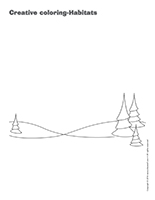
You will need a large piece of cardboard. Ask children to completely cover it with white paint. Throughout the week, they can create an arctic world. Provide a wide range of white material and accessories. Add penguins, polar bears, fish, seals, etc. A few suggestions: marshmallows, sugar, salt, flour, salt dough, white modeling dough, white glue, cotton balls, tissues, egg shells, empty egg carton sections, etc.
The desert
You will need several brown paper grocery bags. Open them and stick them on a wall, at children's level. Add glue and sand and let dry. Throughout the week, encourage children to complete their desert scene by adding animals that live in the desert (use coloring pages, stencils, etc.).
Cactus
(Open models-Cactus) Print and cut out. Children trace the model on construction paper and glue grass, leaves, or any other green material you have on hand all over their shape. Don't forget to add toothpicks! Variation: For a special effect, have children paint their cactus and sprinkle it with salt, sugar, or sand before the paint dries.
Beehive
On a piece of cardboard, trace the outline of a beehive. Glue Honey Comb cereal all over to make it look real.
Three-dimensional home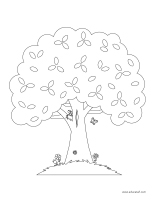
This is a great group project. You will need a large appliance box (refrigerator or stove). Cut windows and a door out of the sides of the box. Use pieces of fabric to represent curtains. Paint the walls of your home, inside and outside. Provide plenty of arts & crafts material and let children create their three-dimensional home as they see fit. When they are done, they will love to play in it. You can add play furniture and accessories. If you wish, your three-dimensional home can make a great reading corner.
COLORING PAGES
(Open coloring pages theme-Habitats) Print for each child.
CREATIVE COLORING
(Open creative coloring-Habitats) Print for each child. Invite children to draw one of the habitats discussed during the theme.
SCRAPBOOK-MY HOME
(Open scrapbook-My home) Print this new scrapbook page for each child. Encourage children to draw the room they enjoy most in their house. Insert the scrapbook page in each child's scrapbook when they are done.
SONGS & RHYMES
(Open songs & rhymes-Habitats)
By: Patricia Morrison Sung to: The wheels on the bus
Habitats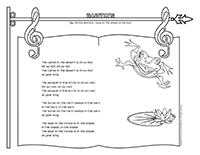
The camel in the desert is oh so hot
Oh so hot, oh so hot
The camel in the desert is oh so hot
All year long
The penguin in the Arctic is oh so cold
Oh so cold, oh so cold
The penguin in the Arctic is oh so cold
All year long
The horse on the farm sleeps in the barn
In the barn, in the barn
The horse on the farm sleeps in the barn
All year long
The bear in the forest is in the shade
In the shade, in the shade
The bear in the forest is in the shade
All year long
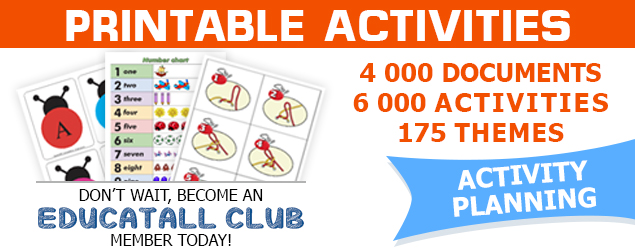
 Home
Home Theme activities
Theme activities
 Babies and toddlers
Babies and toddlers
 Arts and crafts
Arts and crafts
 Science
Science
 Creative recipes
Creative recipes
 Tips and tricks
Tips and tricks
 Special needs
Special needs
 Extra activities
Extra activities
 Educ-TV
Educ-TV
 Newsletter
Newsletter  Online store
Online store Educatall club
Educatall club

